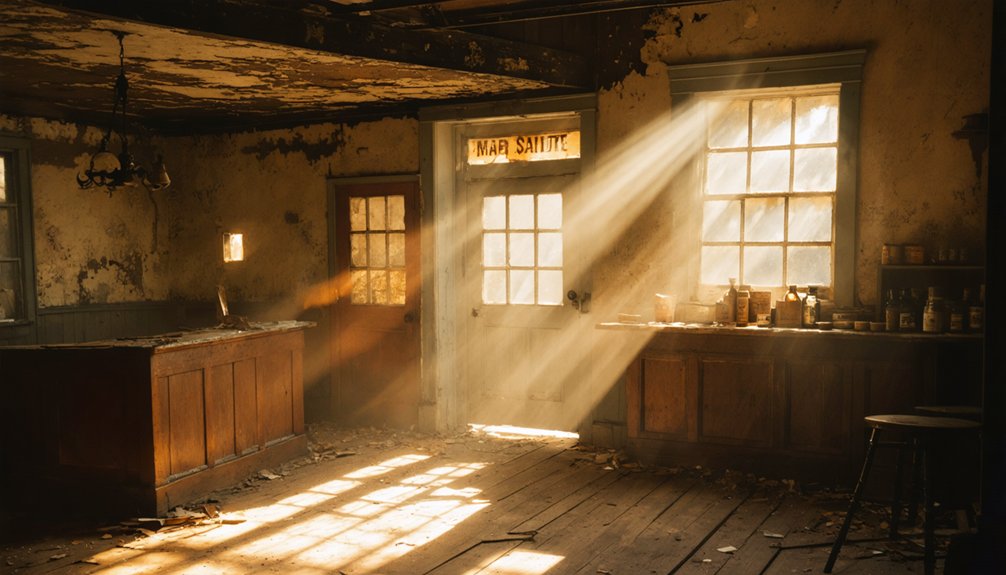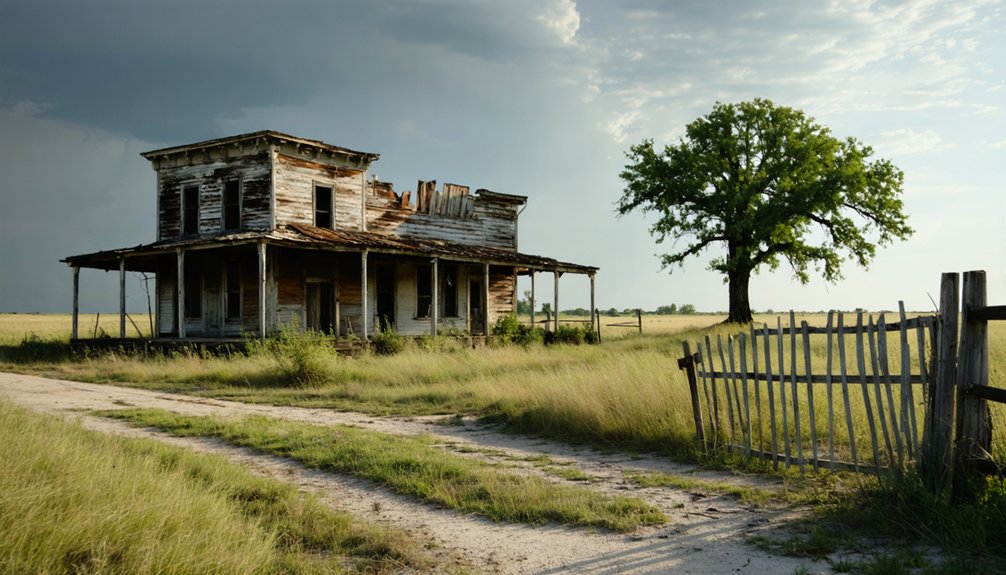You’ll find this northwest Harris County ghost town‘s remnants near where Spring and Cypress roads once intersected. In 1914, Louetta thrived with 200 residents, a post office, cotton gin, and essential railroad connections to Houston and Dallas. Economic decline struck when rail routes bypassed the town, while Klein’s growth drew away commerce. Today, weathered structures and rusted equipment behind protective fences reveal Louetta’s agricultural and industrial past.
Key Takeaways
- Louetta was a thriving agricultural town in Harris County that peaked around 1914 with 200 residents and a bustling post office.
- The town’s decline began when railroad routes bypassed Louetta, eliminating essential rail connections to Houston’s commercial network.
- Ghost town remnants include weathered wood structures, stone buildings, and rusted industrial equipment behind protective fences amid reclaimed vegetation.
- The nearby growth of Klein drew businesses and residents away, while natural disasters and transportation changes further isolated the community.
- Louetta officially dissolved in 1946, with its territory now part of Klein Independent School District in suburban Harris County.
Early Settlement and Post Office History
While the late 19th century saw many Texas settlements emerge, Louetta established itself as a thriving agricultural and industrial hub in Harris County.
You’ll find that settlement patterns centered around sugar and syrup production, with the fertile land attracting industrious settlers who established sawmills, cotton gins, and grist mills.
The town’s growth paralleled the establishment of its post office, which became a crucial cornerstone of community life.
As a critical communication link, the postal service facilitated commerce and correspondence, cementing Louetta’s regional significance.
Similar to Toyah’s early development as a major cattle-shipping point, Louetta’s postal significance extended beyond mail delivery, transforming the office into a recognized community hub that supported the town’s expanding industries.
Like other Texas towns such as Ayr, Louetta’s fate was heavily influenced by railroad development decisions.
This combination of postal services and industrial growth positioned Louetta as a promising settlement until the late 1890s, when surrounding towns began drawing activity away.
Peak Population and Economic Activity
Louetta experienced its most vibrant period as a railroad commerce hub in the early 1900s, when cotton farming and ranching drove the local economy.
Similar to the rural counties today experiencing severe population decline and economic hardship, Louetta faced significant challenges maintaining its vitality over time.
You’ll find that the town’s agricultural production peaked around 1914, with a cotton gin processing crops from surrounding farms and the railroad facilitating trade connections to larger markets.
The community’s growth remained modest compared to other Texas towns, though the railroad’s presence temporarily established Louetta as a small but active trading point for area farmers and ranchers. Like the town of Fort Griffin, which protected farmers and ranchers in its region, Louetta served as an important support center for local agricultural operations.
Railroad Commerce Hub Growth
As rail lines expanded across Texas in the late 19th century, the small settlement of Louetta emerged as a significant commerce hub, mirroring the growth patterns of other railroad towns throughout the state.
You’ll find Louetta’s commercial significance directly tied to its strategic rail connections with major Texas cities, particularly Houston and Dallas.
The railroad expansion transformed Louetta from a simple agricultural community into a bustling marketplace.
You could’ve witnessed a diverse mix of businesses spring up around the rail lines – warehouses, general stores, blacksmith shops, and hotels.
The town’s economic importance depended heavily on freight volume and passenger traffic, while competition with nearby railroad towns influenced local merchant activity and investment opportunities.
Major rail companies like Houston and Texas Central Railroad shaped Louetta’s development as a regional trading center. The arrival of railroads enabled cotton shipments inland more efficiently from the region.
The improved transportation efficiency was remarkable, as trips that once took days by stagecoach could now be completed in under two hours by rail.
Early Agriculture and Trade
During the late 19th century, agricultural prosperity defined Louetta’s peak economic period, with cotton emerging as the primary cash crop that drove local commerce.
You’d find local farmers practicing crop diversification, cultivating corn and wheat alongside their cotton fields, while also raising cattle and hogs. Similar to The Grove’s early success, the town attracted many agricultural settlers seeking fertile land. The town’s economic engine ran through its cotton gins and gristmills, where farmers processed their harvests for trade.
Local mercantile networks thrived through general stores, with notable merchants like Henry L. Reeves establishing essential trade connections beyond town limits. The area’s commercial activity was significantly impacted when three mercantile stores operated simultaneously by 1890.
You could purchase everything from farm implements to household goods at these commercial hubs. Community institutions, including farmer cooperatives and fraternal organizations like the Woodmen of the World, strengthened these economic bonds, while the local postal service kept trade communications flowing smoothly.
Population Surge Until 1914
The early 1900s marked a remarkable population surge in this small Texas community, with the establishment of the town’s post office in 1907 signaling the start of rapid growth.
Similar to railroad shipping growth seen in other Texas towns of the era, Bartlett experienced significant economic expansion when rail transport arrived in 1904.
The community’s location at the crossing of Spring and Cypress Roads provided strategic advantages for local commerce and transportation.
By 1914, Louetta’s population dynamics reflected a thriving agricultural hub, supporting multiple industries essential to the region’s economic independence.
You’d have found a bustling community centered around two sawmills, a cotton gin, and a gristmill. The local syrup and sugar manufacturer added to the town’s industrial diversity.
The Burlington-Rock Island railroad line connected Louetta to broader markets, enabling farmers and manufacturers to ship their goods efficiently.
This community resilience was evident in the infrastructure that supported skilled labor and commerce, though the town’s prosperity would soon face competition from the growing settlement of Klein.
Factors Leading to Population Decline
While several Texas ghost towns faded due to single catastrophic events, Louetta’s population decline stemmed from multiple interconnected factors starting in the late 1890s.
You’ll find that the closure of sawmills and cotton processing facilities severely limited economic opportunities, while the growing town of Klein began attracting businesses and residents away.
The loss of essential services weakened community cohesion, creating a downward spiral that was hard to reverse.
Young people left for better prospects in urban areas, leaving an aging population behind.
Natural disasters struck devastating blows to the town’s infrastructure, and without resources to rebuild, recovery became increasingly difficult.
The development of suburban centers and changing transportation routes further isolated Louetta, redirecting regional growth and commerce elsewhere.
Transportation and Infrastructure Changes

Louetta’s fate was sealed by major shifts in local transportation patterns, starting with reduced railroad service at its two Burlington-Rock Island stations.
You’ll find that the realignment of Spring and Cypress roads diminished the town’s role as a key intersection point, while nearby Klein’s development drew traffic and commerce away from Louetta’s commercial center.
The loss of essential rail connections particularly impacted Louetta’s industrial base, including its sawmills, cotton gin, and sugar manufacturing operations, which had relied heavily on railroad transport for survival.
Railroad Bypass Impact
During the late 19th and early 20th centuries, major railroad expansions near Northwest Harris County drastically altered Louetta’s fortunes through strategic bypasses and infrastructure changes.
You’ll find that the construction of new routes, like the “Spence Cutoff,” redirected main rail traffic away from smaller towns, greatly impacting Louetta’s economic vitality. The bypass effects were particularly severe as they eliminated essential rail service stops that had previously connected the community to Houston’s growing commercial network.
The changes weren’t just about lost connections – they fundamentally reshaped the region’s transportation landscape.
While the bypasses improved operational efficiency for major carriers and enhanced Houston’s position as a rail hub, they left Louetta increasingly isolated. Without regular rail service, the town struggled to maintain its commercial relevance, leading to decreased investment and eventual population decline.
Road Network Development
The intersection of Spring and Cypress roads once marked Louetta’s central position in northwest Harris County’s early transportation network, where unpaved rural routes served as essential arteries for local commerce.
You’ll find that road accessibility gradually diminished as Klein and Houston drew regional traffic away from Louetta in the early 1900s.
The transportation evolution continued through the mid-20th century when major highways bypassed the settlement, further isolating it from critical through traffic.
Local Transit Patterns Changed
When rail transit began declining in the early 1900s, a profound shift occurred in Louetta’s transportation landscape.
You’d have witnessed the Burlington-Rock Island railway’s diminishing influence as urban migration drew residents toward Klein and other growing communities.
The transportation evolution hit hard when the local post office closed in 1935, further isolating the dwindling population of just 15 residents.
Remnants and Physical Structures

Standing behind protective fences and “no trespassing” signs, Louetta’s ghost town remnants include several weathered wood and stone structures that paint a picture of its abandoned past.
Behind rusted gates and faded warning signs, Louetta’s forsaken buildings stand as silent witnesses to a community long abandoned.
You’ll find collapsed roofs, exposed timbers, and dilapidated frames amid trees and vegetation that have reclaimed the settlement sites. The ruin preservation efforts have protected significant industrial artifacts, including rusted mining equipment and mechanical parts near old windmills.
Near a natural spring, you can spot partially intact walls and foundations that hint at the town’s original layout.
While you can’t access the ruins directly, informal viewing points let you observe these historic structures from a distance. A relatively intact building stands in contrast to its decaying neighbors, suggesting some areas remained in use after abandonment.
Legacy in Harris County History
Beyond the physical remnants, Louetta’s story weaves deeply into Harris County’s historical fabric.
You’ll find its legacy preserved through historical markers and community memories that tell of a once-thriving rural settlement with 200 residents and a bustling post office in 1914. As one of several small communities that shaped North Harris County’s agricultural development in the early 1900s, Louetta’s transformation from incorporated town to unincorporated area mirrors the broader shifts in regional growth patterns.
Though officially dissolved in 1946, Louetta’s influence continues through local education, as its former territory now falls within Klein Independent School District.
The town’s evolution from rural commerce center to suburban space exemplifies the dynamic changes that have shaped Harris County’s development throughout the 20th century.
Comparison to Regional Ghost Towns

Unlike many dramatic Texas ghost towns born from mining booms and busts, Louetta’s transformation into a ghost town mirrors the quieter fate of agricultural communities near Houston.
While places like New Birmingham and Terlingua experienced rapid population swings due to mining ventures, Louetta’s decline followed a more gradual path typical of rural settlements.
You’ll find stark ghost town characteristics when comparing Louetta to other abandoned Texas towns.
Places like Belle Plain lost prominence suddenly after losing county seat status, and Larissa suffered from specific catastrophes like disease outbreaks and railroad bypasses.
In contrast, Louetta’s remaining structures are minimal, lacking the dramatic ruins you’d find in Toyah or Terlingua, where abandoned buildings still stand as evidence of their boom-time prosperity.
Modern Development Impact
Modern development has steadily erased Louetta’s ghost town character, particularly through the expansion of Houston’s suburban sprawl.
You’ll find the Memorial Chase subdivision, built in the 1980s, now occupying much of the original townsite. The area’s transformation reflects intense residential pressure from the growing Klein community and northern Harris County.
Where rail stations and agricultural operations once defined Louetta’s landscape, you’ll now see modern housing developments bordering abandoned railroad corridors.
Urban expansion has shifted transportation patterns away from the historical center, while new highway networks bypass the old townsite completely.
The economic foundation that once supported Louetta’s mills and cotton gins has given way to suburban development, leaving only two abandoned railroad stations as reminders of its past by the 1980s.
Frequently Asked Questions
Are There Any Supernatural or Paranormal Reports From Louetta’s Abandoned Areas?
You’ll find no verified ghost sightings or eerie encounters in Louetta’s abandoned spots – imagine standing in an empty lot where whispers of paranormal activity exist only in unconfirmed local stories.
What Happened to the Original Families Who Lived in Louetta?
You’ll find original residents scattered after railroads bypassed their town, forcing economic migration. Many relocated to nearby communities, though their family legacy lives on through annual reunions and cemetery associations.
Can Visitors Still Access the Former Town Site Today?
You’ll find limited access since there’s no historical preservation site. The area’s now private suburban developments, so you must respect visitor guidelines and property rights to avoid trespassing issues.
Were There Any Notable Crimes or Incidents in Louetta’s History?
You won’t find any documented notable crimes or historical incidents in Louetta’s records. Unlike other Texas ghost towns that experienced violence, Louetta’s history shows it was a peaceful agricultural community that simply faded away.
What Natural Disasters, if Any, Contributed to Louetta’s Abandonment?
You won’t find clear evidence of flood damage or drought impact contributing to Louetta’s abandonment in historical records. The town’s decline appears linked to other factors rather than natural disasters.
References
- https://southwritlarge.com/articles/the-curse-of-old-town-spring/
- https://www.southernthing.com/ruins-in-texas-2640914879.html
- https://www.youtube.com/watch?v=phjUE19A8HM
- https://www.chron.com/news/houston-texas/slideshow/The-lost-towns-of-Houston-72353.php
- https://www.lonestartreasure.com/texas-ghost-towns-and-their-buried-riches/
- https://en.wikipedia.org/wiki/List_of_ghost_towns_in_Texas
- https://www.texasescapes.com/TexasGulfCoastTowns/Louetta-Texas.htm
- https://www.texasescapes.com/TOWNS/Texas-Ghost-Towns-7-Texas-Gulf-Coast.htm
- https://www.click2houston.com/news/texas/2020/06/18/the-ghost-towns-of-texas-5-abandoned-texas-towns-to-check-out-on-your-next-road-trip/
- https://mix941kmxj.com/see-how-two-texas-ghost-towns-battled-for-the-county-and-lost/



